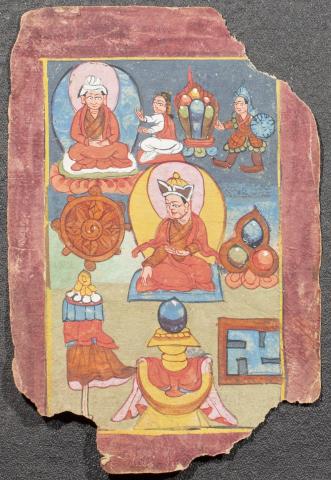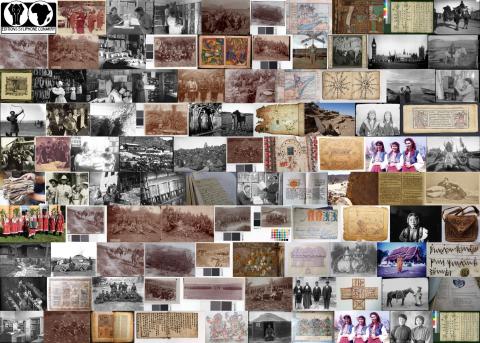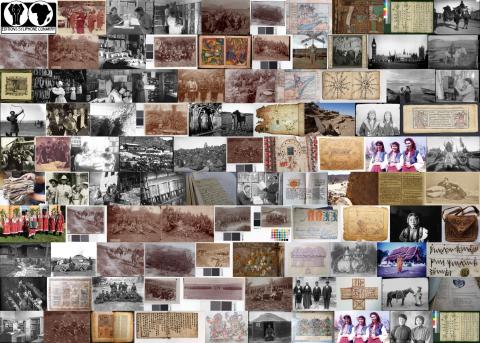Aims and objectives
This project will survey and eventually document the complete holdings of narrative and ritual texts, narrative paintings and other performance related material belonging to the Buchen of Pin Valley, India.
The Buchen are performers of specialist rituals, travelling actors and disciples of the 14th/15th century ‘crazy saint’ Thangtong Gyalpo. They reside in the culturally Tibetan Pin Valley in Spiti, North India. Buchen households possess individual ‘archives’: collections of written story texts, texts of exorcism/healing rituals, thangkas and other ritual paraphernalia. There has never been a systematic survey of this material, and to date, little research.
Buchen texts and thangkas are seriously endangered. Much appears to have already disappeared. Some of the material has been sold, some worn out by heavy use, others damaged by poor storage: changing Himalayan weather patterns are causing significant problems to mud houses in Spiti.
Buchen are most known for an elaborate exorcism called the Ceremony of Breaking the Stone, once performed by related groups across western Tibet. It seems that these groups have ceased performing. Buchen also enact dramatisations of popular folk-tales, performances related to the Tibetan Opera. These Buddhist morality plays illustrate principles of karma and ideas of impermanence, though often lightened with comedy: Buchen spread the teachings of the Buddha through entertainment. This role links them to a wider Tibetan tradition of lay religious performers called lama manipa, who retell the life stories of Tibetan saints whilst pointing out key scenes on narrative painted cloth scrolls (thangkas). This tradition is probably extinct in Tibet though still exists in Bhutan. It is echoed in Buchen performances where the head Buchen narrates the main scenes of the forthcoming play whilst pointing at thangka illustrations.
The Tibetan Opera is performed by professional groups in the major centres of Tibet and the exile community, but the peripheral regional forms of this theatrical tradition that were once performed all over the Tibetan world are under-researched. An archive of Buchen texts and thangkas could offer substantial material to future researchers. There are a dozen or so stories that are performed as plays by the Buchen. There are also other stories which are narrated rather than enacted.
The Buchen archives have never been dated but the material is probably in the range of 60 to 150 years old. The older handwritten texts may be hand-copied versions of significantly older documents. The textual tradition is neither dated nor researched and its physical condition varies substantially.
The project will produce a report of a survey of all the active and dormant Buchen households in the Pin Valley in Spiti. Household by household, it will detail their complete holdings of narrative and ritual texts (pecha) and narrative paintings (thangkas). It will also detail their other performance related materials, including masks, costumes, statues, printing blocks, ritual objects and musical instruments. Some digital sample copies will also be produced.
Outcomes
All the ‘active’ Buchen households in Pin were identified and a list produced of their holdings of Buchen related material. A number of very old texts were found, primarily for the stories (namthar) that are narrated or dramatized, many costumes, a few thangkas and statues, as well as other ritual instruments. Of particular interest are the old texts of the stories of Lingza Chokyit, Drimed Kunden, Nangsa Odbum, Drowa Zangmo, the story of Tngtong Gyalpo’s first disciple Ranapatta (Rhatna Bhadra) and the tantric text for the stonebreaking, known as Daley. Also of great interest was an old thangka illustrating the judgement of the dead and the processes through which sinners are tortured in the 18 Buddhist hell realms. The identification of the dormant households was significantly more complex and less material was discovered than had been hoped. However a substantial number of dormant households were identified both within the Pin valley and in the wider geographical area.
The copies of the material that were digitised have been deposited with the Library of Tibetan Works and Archives in Dharamsala in India, and with the British Library.
The records copied by this project have been catalogued as:
- EAP548/1 The texts (pecha), cloth scroll paintings (thangka), and other performance-related objects belonging to Meme Dorje Phuntsog [mid 19th century-21st century]
- EAP548/2 The texts (pecha), cloth scroll paintings (thangka), and other performance-related objects belonging to Meme Tsering Tobgye [19th century-early 21st century]
- EAP548/3 The texts (pecha), cloth scroll paintings (thangka) and other performance-related objects belonging to Meme Chhettan Dorje [mid 19th century-20th century]
Due to the cyber-attack on the British Library in October 2023, the archives and manuscripts database is currently inaccessible and we are unable to provide links to the catalogue records for this project.




